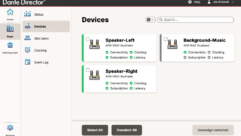
Management Perspectives: Choosing Mailing Lists for your Newsletter
Nov 1, 2006 1:00 PM,
By Don Kreski
Click here to read more Management Perspectives columns


One of the most important decisions you’ll make in publishing a newsletter is where you’re going to mail. If you don’t have a good list, your newsletter will never get the results you want, no matter how much you invest in writing, photography, and production.
Most companies that produce a newsletter have two goals. First, they want to keep in touch with current customers and known prospects, to stay on these people’s radar, build their brands, and prompt phone calls and emails. They also want to reach out to new people, with the idea of bringing in leads and orders they might not otherwise get.
To reach the first goal, you almost certainly will want to mail to your customer and prospect lists as compiled in ACT, Outlook, or a similar contact manager. You may also want to include names from your accounting system, warranty registrations, and various customer communications. You should definitely ask visitors to your website to subscribe to your newsletter. If you have a log-on for certain portions of your site, or if you offer downloads of a white paper or brochure, that can also be an opportunity to collect email or postal addresses. There are some rules you need to follow in collecting these addresses (more below), but your existing customers are an obvious and critical source of new business.
To reach the second goal, you’ll want to consider buying or renting outside mailing lists. Jim Hauschild, president of Alpine List Group, a list broker based in Park City, Utah, says there are several things to consider when choosing a third party mailing list. Let’s explore them.
Compiled vs. response lists
“People in the business often categorize mailing lists two ways,” Hauschild says. “There are compiled lists and response lists.” Compiled lists are essentially directories compiled from any of a number of different sources, including corporate filings to the government, labor filings, and phone directories. Response lists include magazine and newsletter subscribers, catalog buyers, conference attendees, and association members.
“The difference,” Hauschild says, “is that with a response list a person is on the list because he or she has responded to an offer in the past and, in theory at least, is more likely to respond in the future. Generally speaking, these lists are more up to date and accurate.” Hauschild says he normally recommends response lists to his customers, although there are times when compiled lists are appropriate.
Hauschild’s second criterion is the type of selection options available from the list owner. List owners will generally specialize in a particular type of customer, whether that means a vertical market by industry or specific job titles within an industry or across industries.
Examples of compiled lists by industry would include Market Data Retrieval’s educational lists and SK&A Information Services’ lists in the heath care industry. Both take unusual care in compiling their data, says Hauschild, and both can bring you a very good response.
Association lists are considered response lists because those included must decide to join the association and renew their membership regularly. Some examples of note are the American Institute of Architects (AIA), American Society for Training and Development (ASTD), and ISTE, the International Society for Technology in Education. The downside, according to Hauschild, is that associations tend to be protective of their membership. They rarely provide email addresses or phone numbers, and thus most association lists can be used for postal mail promotions only. As with all response lists, they will always ask for a copy of the mailing piece up front, and they will refuse to supply their list for offers that might be objectionable to their members.
Trade magazines are very good sources of response lists. “We order a lot of magazine lists for our clients,” Hauschild says. “You can usually sort them by title, industry, company size, sometimes by revenue. That’s because in order to subscribe, you have to fill out a subscription card with this information. The list owners download it verbatim into their database.” Subscription list owners will often provide email addresses and telephone numbers, so you have more flexibility than you would using association lists.
Some examples of note to the AV industry include CIO Magazine, Infoworld, Sound & Video Contractor, and Training. If you work with a good broker you can find lists of facilities managers, architects, IT directors, corporate trainers, school technology people, churches, and universities—almost any market you choose.
Response and compiled lists can always be sorted geographically, so if you’re at a regional integrator or contractor, you can rent just the area you serve.
Email vs. postal mail
Because list owners (and individual people) tend to be protective of email addresses, there are a lot more names available on postal lists than email lists. For that reason Hauschild suggests a mixture of email and postal mail promotions.
One issue is cost. In a large postal mailing, Hauschild says you should expect to invest 15 percent to 30 percent of your total budget on the mailing list, the rest going to creative, printing, mailing and postage. In an email promotion, however, nearly all of your cost (outside of creative) will be on the mailing list, and in some cases you can pay up to four times as much per name.
It’s important to realize that when you use an outside list, you are normally renting rather than buying the addresses. “List owners all seed their lists with a few bogus addresses,” Hauschild says, “so they can make sure that you’re mailing the offer which you submitted for approval and make sure you only use it one time.” If you regard the list as your own and try to use it over and over without permission, you should expect legal action. You should also realize that, in the case of email lists, you’re unlikely to get that opportunity. List owners normally include the broadcast with the price of rental, and they will not release email addresses to you.
Legitimate email vs. spam
One worry when you look at lists offered for outright purchase is whether they are permission based.
The CAN-SPAM Act of 2003 regulates how you can use email as a marketing tool. According to the FTC website, the act bans false or misleading header information, bans deceptive subject lines, requires that commercial email be identified as such, requires inclusion of the sender’s valid postal address, and requires that you provide a working opt-out mechanism.
In addition, ESPC, the Email Sender and Provider Coalition, suggests in their Best Practices Guide that you confirm the willingness of each email recipient to receive email from you, even those with whom you have a prior business relationship. That is to say, if you decide to send the newsletter to your entire customer and prospect list, it’s best practice to ask first if individuals want to receive email from you. Once you send the newsletter, you absolutely have to give them the opportunity to refuse future issues.
When you rent or buy a list from a legitimate provider, you should be looking for permission-based lists where recipients have indeed agreed to receive email from third parties. On the other hand, if a list offer seems too good to be true, it may be, and it could conceivably land you in legal trouble.
I do not mean to discourage you from publishing a newsletter. “Some people have the misconception that all email marketing is spam,” Hauschild explains. “The issue is not whether you send email, but whether the list to which you are sending your message is permission-based.” I personally send an email newsletter to my own customers and prospects, and while some people have opted out, many more have told me how much they enjoy receiving it. Overall, it’s been very successful both in bringing in new customers and in prompting current customers to send me new projects. It has been more than worth my investment.
More information
You can reach Jim Hauschild at [email protected]. The FTC explains the CAN-SPAM Act at www.ftc.gov/spam. Visit ESPC at www.espcoalition.org.
Contact Don Kreski with any questions at www.kreski.com/contact.html.










